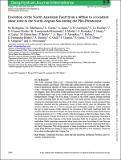Por favor, use este identificador para citar o enlazar a este item:
http://hdl.handle.net/10261/348304COMPARTIR / EXPORTAR:
 SHARE SHARE
 CORE
BASE CORE
BASE
|
|
| Visualizar otros formatos: MARC | Dublin Core | RDF | ORE | MODS | METS | DIDL | DATACITE | |

| Título: | Evolution of the North Anatolian Fault from a diffuse to a localized shear zone in the North Aegean Sea during the Plio-Pleistocene |
Autor: | Rodriguez, Mathieu; Sakellariou, Dimitris; Gorini, Christian; Janin, A.; D'Acremont, Elia; Le Pourhiet, Laetitia; Chamot-Rooke, N.; Tsampouraki-Kraounaki, K.; Morfis, I.; Rousakis, G.; Henry, Pierre; Lurin, A.; Delescluse, M.; Briole, P.; Rigo, A.; Arsenikos, S.; Bulois, C.; Fernández-Blanco, David CSIC ORCID ; Beniest, Anouk; Grall, C.; Chanier, Frank; Caroir, F.; Dessa, J.-X.; Oregioni, D.; Nercessian, Alexandre | Palabras clave: | Continental tectonics: strike-slip and transform Submarine Tectonics and volcanism Transform faults |
Fecha de publicación: | dic-2023 | Editor: | Royal Astronomical Society | Citación: | Geophysical Journal International 235(3): 2614-2639 (2023) | Resumen: | The North Anatolian Fault is the ∼1200-km-long active continental transform boundary between Anatolia and Eurasia. This strike-slip system initiated around 10–12 Ma and experienced diachronous episodes of strain localization along its strike. The structural evolution of the ∼350-km-long fault segments crossing the North Aegean Sea remains to be accurately investigated. There, the modern North Anatolian Fault is localized along two main branches: the northern branch ends at the North Aegean Trough and the southern branch ends at the Edremit-Skyros Trough. The Evia Basin is located in the North Aegean Domain between the North Anatolian Fault and the Corinth Rift. This study presents seismic reflection lines crossing the aforementioned structures of the North Aegean Domain, which document their subsurface structure and the sedimentary record of their activity since the Messinian. The seismic-reflection data set is tied to regional-scale stratigraphic markers, which constrains the age of main tectonic events related to the formation of the North Anatolian Fault. The seismic-reflection lines show that the two main branches of the North Anatolian Fault became localized structures at 1.3–2 Ma, coevally with the formation of the Evia Basin. Since 2 Ma, the North Aegean Troughs developed as a series of horsetail basins propagating westwards at the termination of the branches of the North Anatolian Fault. On a regional scale, the wide and diffuse North Anatolian transtensive shear zone active from Serravalian to Late Pliocene turned into a narrower shear zone at the two main branches of the North Anatolian Fault since the Early Pleistocene. This abrupt episode of strain localization occurred in the frame of the major Early Pleistocene change in stress regime from NE–SW to N–S extension, which has been observed throughout the Aegean Sea | Descripción: | 26 pages, 21 figures.-- Data Availability: Seismic reflexion data set available on request to Dr M. Rodriguez (rodriguez@geologie.ens.fr) and Dr M. Delescluse (delescluse@geologie.ens.fr). Multibeam data set available on emodnet https://emodnet.ec.europa.eu/en/bathymetry | Versión del editor: | https://doi.org/10.1093/gji/ggad364 | URI: | http://hdl.handle.net/10261/348304 | DOI: | 10.1093/gji/ggad364 | ISSN: | 0956-540X | E-ISSN: | 1365-246X |
| Aparece en las colecciones: | (ICM) Artículos |
Ficheros en este ítem:
| Fichero | Descripción | Tamaño | Formato | |
|---|---|---|---|---|
| Rodriguez_et_al_2023.pdf | 6,61 MB | Adobe PDF |  Visualizar/Abrir |
CORE Recommender
SCOPUSTM
Citations
2
checked on 21-abr-2024
Page view(s)
13
checked on 29-abr-2024
Download(s)
6
checked on 29-abr-2024
Google ScholarTM
Check
Altmetric
Altmetric
NOTA: Los ítems de Digital.CSIC están protegidos por copyright, con todos los derechos reservados, a menos que se indique lo contrario.
